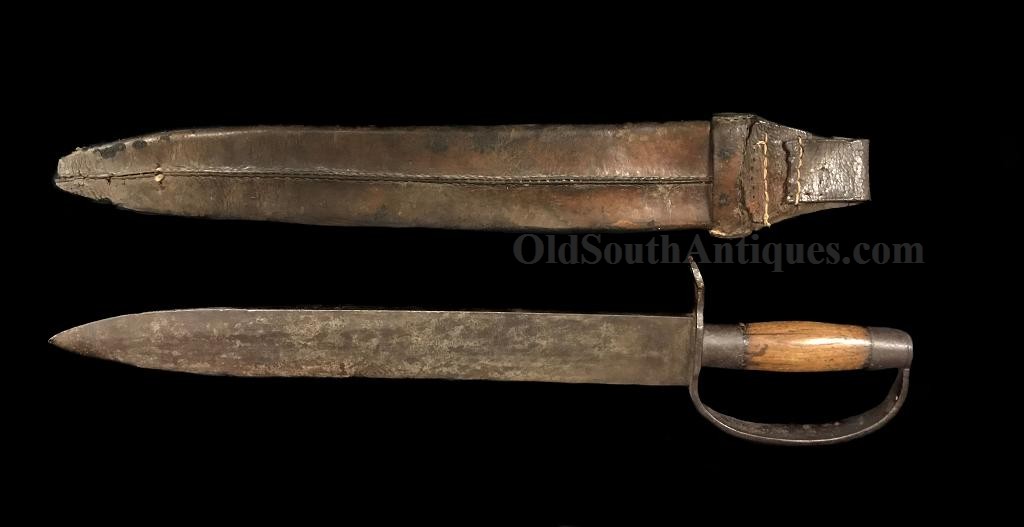
| Catalog | Past Items | Order Info | Terms/Conditions | About Us | Inventory Clearance |
T. L. Pruett was a blacksmith by trade and evidently a very skilled artisan judging by the workmanship exhibited in his D-guard knives. The huge weapon he produced was of the very highest quality. In 1860, forty year old T. L. Pruett, a native Kentuckian, was plying his trade just east of Montgomery, in Prattville, Autauga County, Alabama. When War was forced upon the South, Pruett, like many other craftsmen, utilized his skills to aid the South. In the fall of 1861 he made knives for the Autauga Guards, then, in June of 1862, he enlisted in the 1stBattalion Alabama Partisan Rangers, Co A at Camp Forrest, Alabama. Pruett’s metalworking skill must have attracted attention because the following June, Major General Buckner ordered him to Mobile to work on C. S. gunboats.
Pruett’s ultimate fate is unknown though a year later he was listed on the Ranger’s rolls as being on detached service by order of General Buckner.
The huge iron mounted D-guard Pruett created is nearly twenty-two inches long, over two inches wide and over a quarter inch thick! The flat spear point blade has a three inch reverse edge. The wooden handgrip is set into two iron ferrules.
There are two maker marked examples of Pruett’s rare knives shown here for comparison.
Pruett’s knives were made in Prattville,Autauga County, Alabama. They were made for the Autauga Guards under Captain T. L. Faulkner. By the end of September 1861, Pruett had supplied all 39 enlisted men in Captain Faulkner’s Autauga Guard with a huge iron mounted D-Guard knife with a nineteen inch blade, as witnessed by the October 19, 1861 edition of Vanity Fair published in Boston, Massachusetts under the heading:
Alabama "Blades”
"We gather the following cheerful item from a late Southern journal.
‘In Captain Faulkner’s company, of Autauga, Alabama, about to start for Richmond,
each man is furnished with a knife, the blade of which is nineteen inches long, and weighs two
pounds and a half.’ You couldn’t have made those blades twenty inches, Captain, could you?
Nineteen is such an awkward number of inches to have stuck into one you see. But, perhaps,
each of your men is ‘just nineteen years old,’ and ‘can whip his weight in wildcats (or Yankees)
in nineteen minutes.’ If so, the nineteen inches’ are happy.
By the way, Captain, if you have not determined on a name for your company of ‘blades,’ let us
suggest one. What do you think of dubbing them the Autauga KNIFE-AND-FAULK-NERS”
The thirty-nine knives referred to in Vanity Fairprobably accounts for all the knives Pruett made, certainly for all the knives of this massive style. Up until this unmarked, but unmistakably Pruett knife turned up, after extensive research, I believed that only four out of the original thirty-nine had survived. Three mounted in iron and one brass mounted example. Now this adds one more to this short list.
At the time the article was written in a "Southern journal” the Autauga Guards thought they were headed for Richmond, Virginia; instead they became company G, Blythe’s Regiment, 44th Mississippi Infantry and served out the War in the Army of Tennessee.
The knife is still sheathed in its original leather scabbard, one of only two known to exist. Less than ten of these knives are known to have survived in any condition, and most of these are in very poor condition and without scabbard. One nice example is known to be in its original tin scabbard, making three examples with scabbards known to exist in 2019.
Both the knife and its scabbard are in excellent, unaltered condition.
Copyright © 2025 OldSouthAntiques.com All Rights Reserved.
Privacy Policy | Terms of Use
Powered by Web-Cat Copyright © 1996-2025 GrayCat Systems

